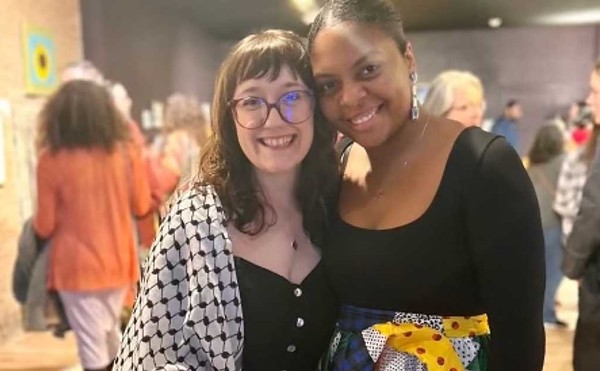Playing Stephen Schudlich's "Urban Village" game at Wayne State's Elaine L. Jacob Gallery calls to mind a first-season skit from Kids in the Hall, where editors William and Wonter, while walking around town, get overzealous and begin bowdlerizing their environment:
"How do you feel about that mailbox?"
"Hmm, too red."
"Lose it!"
"Feelings about the paper box?"
"Eh, like the box, hate the headlines. Lose the news!"
"Nice looking couple. I like the girl."
"Mmmm ... hate the guy."
"Strike him!"
For less absurd reasons, that's totally a game a lot of Detroiters have played while cruising the city: Where would you "relocate" a $5 prostitute? If you could, would you shut down Mickey Ds? Would you put a couple of liquor stores out of business on a street with no market? Would your choices strengthen the neighborhood or squander its vital resources?
"Urban Village" is your chance to figure it out. One observer calls Schudlich's game "Jane Jacobs meets Sim City." It's an opportunity to develop a hybrid Detroit community, based on the less-than-perfect socioeconomic conditions provided.
The game is featured in Shrinking Cities? Wayne State Responds, a group exhibit inspired by the other Shrinking Cities, a German-funded show about depopulation and disinvestment in Detroit and five European cities, currently at Cranbrook Art Museum and MOCAD. In Wayne State's show, artists display the deeply personal effect this city has had on their psyche. Emily Linn, for instance, sews a patchwork photomontage of homes she grew up in, and Ericia Bartels-Dawkins has an altar dedicated to the Motor City.
"Urban Village" is based on an east side strip of Mack Avenue between Mt. Elliott and St. Jean near where Schudlich lives. Wooden blocks branded with icons represent elements of the depressed neighborhood catalogued by the artist: more drug activity than drug stores, one broken traffic signal and two car repair shops, and the frowning faces of abandoned and burned homes.
Fred Goodman, a University of Michigan professor of education emeritus specializing in game design, defines Urban Village as "a cross between pin the tail on the donkey and playing school," he says. "You're playing city planner, and you can get dizzy trying for the best fit because it's harder than you think. But this inspires you to think about the inconsistencies of your own set of assumptions, revealing your own values and biases."
When the time came for me to move the blocks, I impulsively got rid of all liquor stores, the fast food joint, illegal dumping, and as many abandoned and burned houses as I could — even a couple of candy stores (I had no idea there were so many on Mack Avenue). Rather than banishing the panhandlers, I placed them near churches and shelters in the naive hope that churches — even those on Mack Avenue, which could be rip-offs or shuttered — would welcome the poor. The prostitute took a trip to the medical clinic, while the drug activity and stray dog were strategically maneuvered near the casino. I put vacant lots alongside community gardens because, naturally, gardens grow, and set up a nice little five-block area including houses, a school, a playground, coin laundry, mailbox, pizza joint, music store and bank. Which is why watching a friend take his turn and ruin my hard work made me mad.
"Please," he said. "Banks are total scams." He picked up the wooden block with the Greek temple on it and moved it near the ones with the cute crack pipe and the burger and soda on them. I called him a radical, and that's when he pointed out that I had banished a bar, thereby constructing a neighborhood even I wouldn't want to live in. That's when I realized: To reduce, to take away, is an easy process. Figuring out how to occupy the land you have and dealing with all the ramifications — coping with what you've got — is much more complex.
While Schudlich doesn't suspect City Hall is going to call him any time soon and put him to work (although the volunteer community group Detroit Synergy has expressed interest in displaying his game at a meeting), he says the whole point of it was to get people visually engaged in abstract issues. Plus, he learns something about the public too.
At the gallery, he has set out a punch card, asking players to make holes on the card next to the names of elements they removed, and deposit the survey in a locked box.
"I had one person write something in on the ticket — they said, 'I'm sorry, but I just had to get rid of these panhandlers.' It's like they said, 'I don't care about the rules; I'm going to overstep the boundaries of the community.' You know, I don't know what that means. Apparently, they feel that strongly about it that they're saying, 'I'm going to find a way to get them out.' With a play block game, it's as easy to put them on another shelf. But given the opportunity, what would they do in real life?"
To Play the Game:
1. Print out the game pieces. (pdf, Adobe Reader required).
2. You will need scissors, and masking or scotch tape.
3. Preparation: Cut out the squares along the indicated lines. Create a street by placing a straight line of tape on a floor or a tabletop. This line should be about 4 feet long.
4. Instructions: Using the squares provided, construct your own urban village by placing 59 elements in any order along your street. There are 6 elements that may be moved anywhere on the street but not removed from the village. These are printed in gray. Twelve elements, however, may be removed from the village and set aside.
Shrinking Cities? Wayne State Responds runs through April 6, at Elaine L. Jacob Gallery, 480 W. Hancock St., Wayne State University campus, Detroit; 313-993-7813.
Rebecca Mazzei is Metro Times arts and culture editor. Send comments to [email protected]





